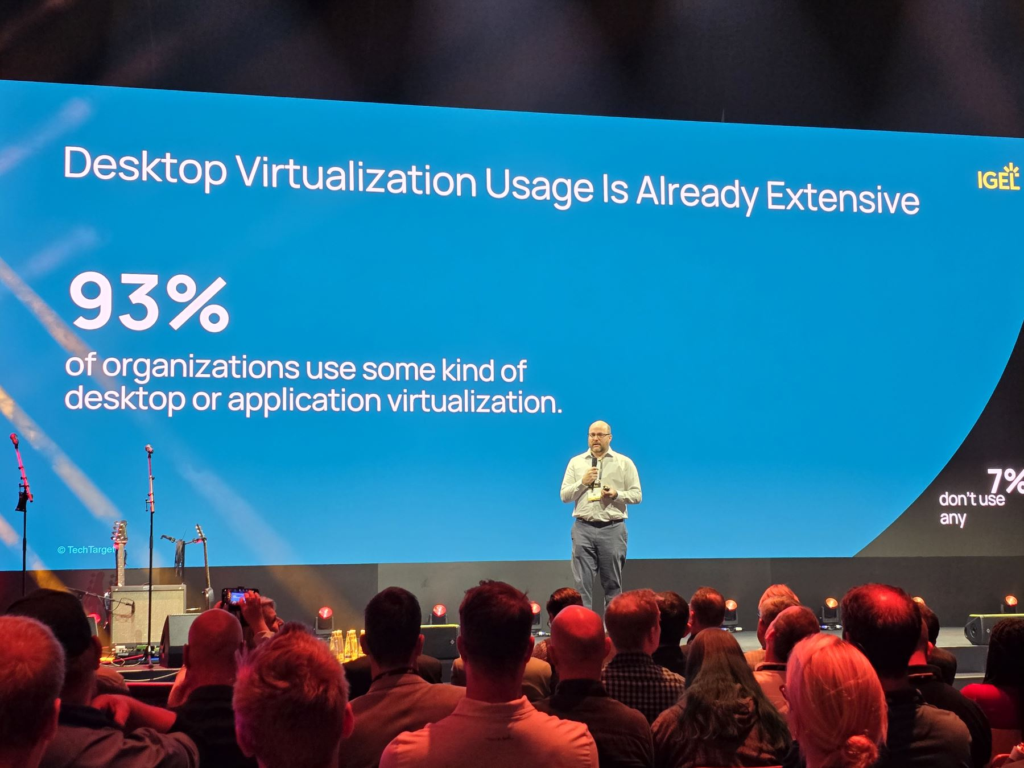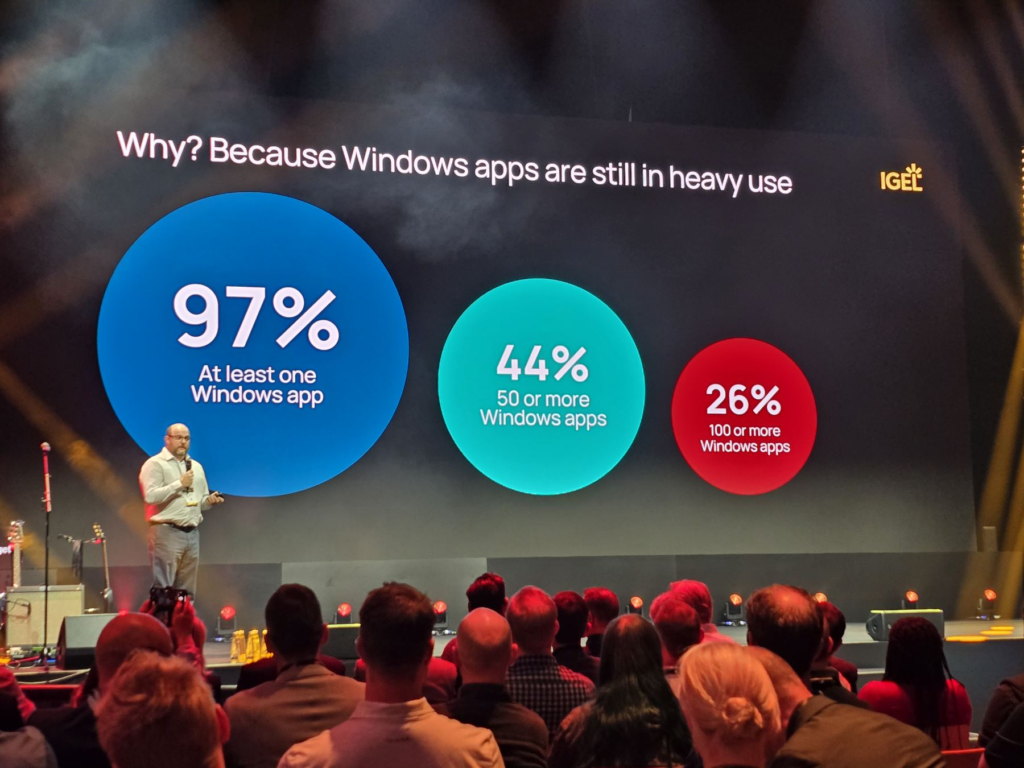They say the only things to survive a nuclear attack would be cockroaches and Windows Apps, having just returned from IGEL Disrupt in Munich and listened to Gabe Knuth’s keynote this is very much the case. In Gabe’s keynote he noted how we are not in a SaaS/Web App utopia that some predicted but windows apps will very much be part of companies strategies for a long time to come.
Why Windows Applications Remain Essential in a Virtualized World
As organizations accelerate their digital transformation journeys, the adoption of desktop and application virtualization has seen a significant uptick. Virtualization offers businesses unparalleled flexibility, improved security, and enhanced management capabilities. Yet, despite the growing trend towards virtualized environments and SaaS applications, Windows applications remain deeply embedded in the fabric of most organizations
In this blog, we will look at why Windows Apps are here for the foreseeable future, the obstacles to removing them and how Liquidware FlexApp is vital in an modern application strategy
The Rise of Virtualization and SaaS Applications
The momentum behind desktop and application virtualization is unmistakable. According to recent data, 93% of organizations are now leveraging some form of virtualization, whether it’s through Virtual Desktop Infrastructure (VDI), Desktop-as-a-Service (DaaS), or application virtualization solutions. This widespread adoption reflects the many benefits of virtualization: streamlined management, reduced hardware costs, and increased security are just a few of the advantages driving this shift.

However, even with this heavy reliance on virtualization, organizations aren’t turning their backs on traditional Windows applications. While SaaS and browser-based apps are rapidly growing in number—nearly 37% of organizations use between 26 to 100 SaaS applications—Windows apps continue to play a critical role. These applications are often the backbone of operations, deeply integrated into workflows, and essential for day-to-day business processes.

Persistent Use of Windows Applications
Windows applications, often seen as the workhorses of the business world, remain stubbornly relevant. A staggering 97% of organizations report that they still use at least one Windows application. Even more striking, 44% of businesses use 50 or more Windows applications, while 26% rely on over 100. This persistent use of Windows apps highlights their critical role, even as organizations adopt virtualization and cloud solutions at an accelerated pace.

These statistics aren’t just numbers; they reflect the continued dependence on specialized software that often lacks viable SaaS alternatives, the need for legacy support, and the challenge of replacing deeply embedded systems that power essential functions like accounting, supply chain management, and customer relationship management.
Barriers to Fully Moving Away from Windows Applications
Legacy Systems: Many organizations still rely on legacy systems that are compatible only with Windows applications. Replacing these systems is often cost-prohibitive and disruptive.
Specialized Software: Industry-specific software solutions are frequently built for Windows environments and lack equivalent SaaS versions, making them irreplaceable in certain workflows.
Compliance and Security: Regulatory requirements may necessitate the continued use of Windows applications, particularly in industries where data security and compliance standards are stringent.
Integration Complexity: Windows applications are often tightly integrated with other systems and databases. Transitioning these complex integrations to cloud-based alternatives can be risky and time-consuming.
User Familiarity: For many organizations, the user experience and familiarity with Windows applications mean less training and faster adoption of new processes, making it a preferred choice over unfamiliar SaaS interfaces.
Anticipating the Future: Windows Applications and SaaS Alternatives
¢ 32% expect to replace all Windows apps with SaaS alternatives.
¢ 35% foresee replacing more than half of their Windows applications.
¢ 20% anticipate replacing fewer than 50% of their Windows applications.
¢ 7% predict no change in their Windows app usage.
¢ Interestingly, 5% of organizations expect some of their SaaS apps to revert back to Windows applications.
This trend indicates a shift in strategies as organizations seek to modernize their application portfolios. However, the road to full replacement is not without its challenges, and many companies will continue to need robust solutions to manage a hybrid environment where both Windows and SaaS applications coexist.
The Future of Windows Applications in a Virtual World
Looking ahead, virtualization adoption is expected to grow, with predictions that by 2026, 38% of organizations will have 76-100% of their devices accessing virtual desktops or applications. Despite this growth, Windows applications are not going away anytime soon. Instead, we are likely to see a hybrid approach where virtualized environments coexist with traditional Windows applications.
Strategic Considerations for IT Leaders
IT leaders must recognize that while virtualization and SaaS adoption will continue to expand, Windows applications will still play a significant role in most organizations’ IT strategies. The most important strategy for IT Leaders is have the correct application strategy in place. Liquidware have developed a strategy to help IT Leaders because sometimes knowing where to start is the most overwhelming thing.

You can read our application strategy here
Liquidware FlexApp: A Key Part of Your Windows Application Strategy
One of the most effective ways to ensure the ongoing viability and performance of Windows applications in a virtualized environment is through the use of application portability solutions like Liquidware’s FlexApp. FlexApp allows organizations to deliver Windows applications dynamically to any Windows workspace, whether physical, virtual, or cloud-based, without traditional installs.
Key Benefits of FlexApp in any Windows Application Strategy:
Seamless Application Delivery: FlexApp separates applications from the underlying OS, allowing for on-demand delivery to any device, which simplifies application management and ensures consistency across environments.
Reduced Image Bloat and Complexity: By decoupling applications from the base image, FlexApp helps reduce the size and management complexity of desktop images, leading to faster deployments and updates.
Improved User Experience: FlexApp ensures that Windows applications perform as expected in any environment, maintaining the familiar user interface and functionality that employees rely on.
Enhanced Security and Compliance: By centralizing application management, FlexApp helps ensure that applications are up-to-date with the latest security patches, supporting compliance efforts.
Future-Proofing Your IT Strategy: FlexApp’s flexible approach to application delivery ensures that your organization is ready to adapt to future changes in virtualization technology and application needs.
Windows applications are here to stay, and their continued use alongside growing virtualization trends presents both challenges and opportunities for IT leaders. By embracing solutions like Liquidware FlexApp, organizations can optimize their Windows application strategy, ensuring seamless integration, performance, and management across all environments. As virtualization continues to evolve, having a robust strategy for Windows applications will be essential in maintaining operational efficiency and meeting business needs.
Experience FlexApp today and see how easy managing your Windows applications can be. Try it today
*All data is from Gabe Knuth’s Keynote at IGEL Disrupt Munich 2024*








Leave A Comment
You must be logged in to post a comment.